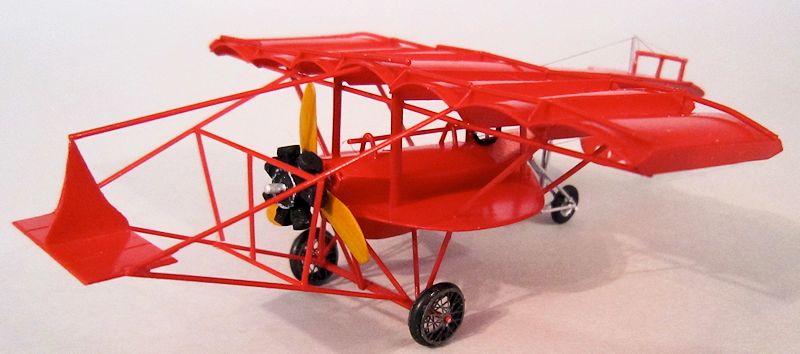
1/72 Moisant Red Crayfish
| KIT #: | |
| PRICE: | |
| DECALS: | |
| REVIEWER: | Chris Peachment |
| NOTES: | Scratch-built |

| HISTORY |
The pioneer aviator John Moisant was as famous in his day as the Wright
brothers, and the New Orleans airport, still bears his name in the initials MSY,
which stood for Moisant Stock Yards, on whose land the airport now stands. He
was born American, in Illinois, to parents who were both French-speaking
Canadian, and the beginnings of his life were adventurous, when he
and his brothers moved to El Salvador in 1896 and bought sugar plantations that
made a fortune. While there he led
two failed revolutions and coup attempts against President Figuera in 1907 and
1909. In 1909, President Zelaya of Nicaragua asked him to go to France to
investigate aviation.
He was about 40 when he went to France, and in 1909 he designed the first of two
curious aeroplanes. It was an all-metal sesquiplane, the upper wing of long
aluminum sheets with 6 rolling chordwise corrugations, each supported by a
rectangular chordwise plate or fence between the corrugations.
The fuselage was a streamlined boat shape, in case of accidental landing on
water, although the design would also have lent considerable rigidity. A forward
elevator was controlled with a long rod. Quite why the aircraft
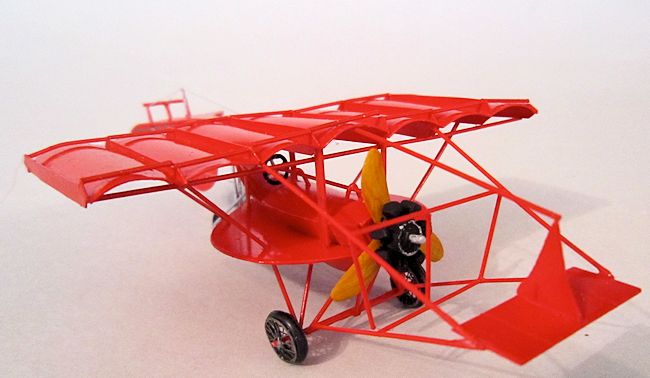 has another
elevator at the rear end is beyond me.
As for its lateral control, I can see nothing like ailerons, and the wing
looks too solid for wing-warping. Perhaps he just trusted to the rudder for
turning, although that would have made the aircraft skid across the sky instead
of banking.
has another
elevator at the rear end is beyond me.
As for its lateral control, I can see nothing like ailerons, and the wing
looks too solid for wing-warping. Perhaps he just trusted to the rudder for
turning, although that would have made the aircraft skid across the sky instead
of banking.
It was not successful, having a tendency to turn over on the ground, though a
note in Popular Mechanics for September 1910 reports several short flights. It
was painted red and known as L'Ecrevisse Rouge - the Red Crayfish.
As a pilot, he
was
the first to conduct passenger flights over a city, across the English Chennel
from Paris to London. He was also
the co-founder of a prominent flying circus the Moisant International Aviators.
On August 17, 1910, he flew the first flight with a passenger across the
Channel. His passengers on the flight were Albert Fileux, his mechanic, and his
cat, Fifi.
Moisant died on December 31, 1910, in an air crash while making a preparatory
flight in his attempt to win the 1910 Michelin cup and its $4,000 prize. He was
caught in a gust of wind as he was attempting to land and was thrown from his
Blériot monoplane, landing on his head.
"Nine-tenths confidence and one-tenth common sense equals a successful aviator."
| CONSTRUCTION |
I
came across this fascinating machine while internet surfing on the excellent
website Their Flying Machines, and began investigation. There are only about 6
photos of the machine, and no plans. And so I set to work drawing up some plans,
working only from the pictures and the wingspan and length measurements. Some of
the pictures show a mechanic standing beside the machine, and, since he looks of
average height, I worked on the assumption that he was about 5 feet 9 inches,
which would have been the norm then, and measured
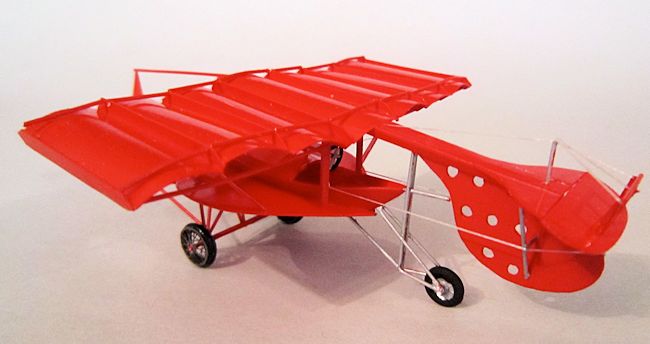 him against the aircraft to
help reckon its dimensions.
him against the aircraft to
help reckon its dimensions.
The wings proved the trickiest things to work out, and I soon realised they
could not be made in one piece. Each corrugation had to be cut separately and
rolled into shape. They were then joined to a succession of oblong fences, which
had their corners cut off. Then spanwise struts were used to join the leading
and trailing edges of the fences, both above and below. It took me two attempts
to get it even halfway right, and some of the struts are still springing free
from their connections. Like all aircraft it needs constant upkeep.
The fuselage is simply two lengths of boat shaped card, joined along the bottom
ridge, and separated up top by internal struts. The upper nose section is a
curved length of card, and above that a steering wheel is mounted on a long
control rod. There is a seat in
there, though you can't see it. The nose plate is triangular, on which to mount
the engine.
I then turned attention to the tail. The girder from the upper trailing edge is
an I-beam from card. The tail is cut from 20 though card, with lightening holes
in the fin, and control horns of the drooped elevator. And the structure for the
rear wheel is made from rod.
Then the front end controls were cut from plastic card, and mounted on lengths
of rod. The elevator is rotated by a solid rod which joins the top of what looks
like a triangular rudder, but is in fact a streamlined actuating rod.
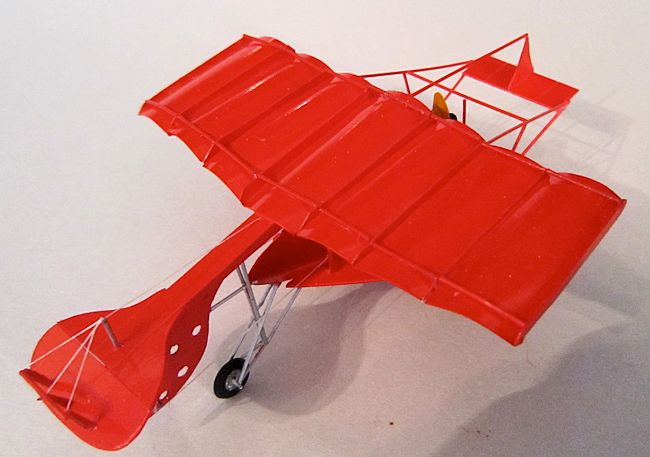 The two lower wings are crescent shaped, cut from card, mounted on the mid point
of the fuselage. Four cabanes were cut from aerofoil rod, the top wing secured,
and then four interplane struts between the wings added
The two lower wings are crescent shaped, cut from card, mounted on the mid point
of the fuselage. Four cabanes were cut from aerofoil rod, the top wing secured,
and then four interplane struts between the wings added
A five cylinder Gnome engine came from the Big Bag of Engines, in the spares
box, as did the propeller, which has wide fans shaped blades. Interestingly it
is mounted on the rear of the rotary engine, between engine and fuselage, an
arrangement I can't recall seeing anywhere else, but one which should work in
theory.
The only evidence of rigging that I can see is on the tail end, and so wires
were put in place from cockpit to elevator and rudder. Other than that, the
beast looks strong enough to be
completely unbraced.
Wire wheels came from an Eduard 1/72 etched set, a handy item which gives you a
full series of sizes. Tyres are rubber o-rings.
| COLORS & MARKINGS |
Nothing very hard here, simply red overall, with some aluminium struts at the
rear end, more for a little tonal variation than accuracy.
| CONCLUSIONS |
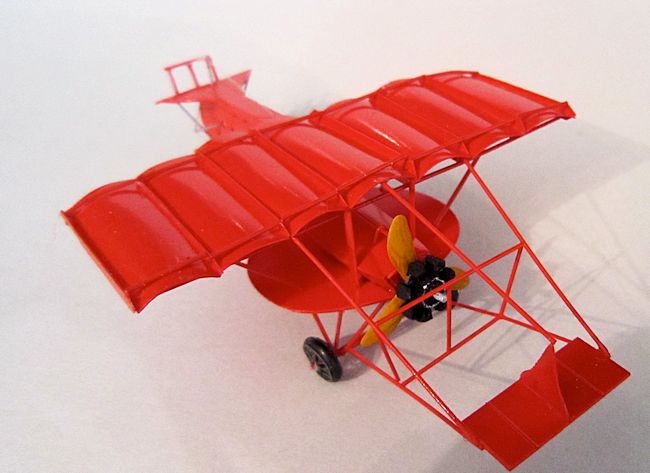 Another strange and unusual design from the pioneering days, although the more
that I look at it, the more I think the design was a good one. The natural lack
of rigidity in thin aluminium would have been countered by hose strong wing
fences. If only it had had ailerons, I suspect that handling would have been
much improved.
Another strange and unusual design from the pioneering days, although the more
that I look at it, the more I think the design was a good one. The natural lack
of rigidity in thin aluminium would have been countered by hose strong wing
fences. If only it had had ailerons, I suspect that handling would have been
much improved.
There is one remarkable photo on one of the websites below of Moisant.
A very handsome man, in a wing collar and homburg hat (sometimes known in
the US as a “Godfather”, since Al Pacino sported one in the film The Godfather),
he has a delightful cat standing on his shoulder. She was called Fifi, and often
accompanied him on flights. Reading between the lines of the details of his
life, he was obviously handsome, rich and confident. But he liked cats so he
cannot have been completely insufferable.
| REFERENCES |
http://flyingmachines.ru/Site2/Crafts/Craft28988.htm
http://www.collectair.com/moisantindex.html
http://members.shaw.ca/flyingaces/br.pre1914/
http://www.nola.com/arts/index.ssf/2010/12/post_35.html
http://en.wikipedia.org/wiki/John_Moisant
June 2014
Copyright ModelingMadness.com. All rights reserved. No reproduction in part or in whole without express permission from the editor. If you would like your product reviewed fairly and
fairly quickly, please
contact
the editor or see other details in the
Note to
Contributors.